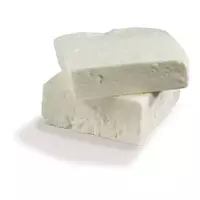Feta cheese

Traditional Greek feta cheese is made from sheep's milk, sometimes diluting it with goat's milk. Interestingly, such cheese should be stored in brine and then the shelf life of the product is almost endless. To remove excess saltiness, feta cheese is soaked in milk or mineral water for a few minutes just before serving.
The word "feta" itself can be translated as "piece" or "slice, " probably precisely because it is prepared in just a large piece. Outwardly, feta cheese is white and resembles young cottage cheese in pressed form, but its taste is more brackish, expressive, with delicate lactic acid. By the way, the aging time of this cheese should be at least three months. Depending on the fat content of the product, which varies from 30 to 60 percent, the calorie content of feta cheese also varies slightly, but averages 264 kcal.
This snow-white delicacy has been produced since the time of ancient Byzantium. Homer himself described the way it was prepared. In those days, containers with milk of sheep were carried out in the sun so that the liquid warmed up to about 35 degrees. After folding the milk, the whey was merged, and the grounds were transferred to linen bags, which were suspended for several days in cane baskets. The finished piece of feta cheese was cut into several pieces for further storage.
Currently, feta-like cheeses are produced in the Mediterranean countries and throughout southeastern Europe, as well as in the Middle East. But it uses mainly cow's milk, in connection with which only a product from Greece can be called feta cheese. Quite often, you can find cheese called fetaki or fetaxa on the shelves. This is practically the same feta cheese, the only difference is in the producing country.
For diets, this product is not suitable due to the rather high calorie content of feta cheese and considerable fat content, which often reaches 50 percent. If you really want, you can afford only a small amount.
Feta cheese is an essential ingredient in the world-famous and much-loved Greek salad, which pairs it admirably with green salad, cucumber, tomato, sweet bell pepper, olives, onions and olive oil. You can treat yourself to this Greek cheese and as a separate dish, a little adding to it with fragrant fresh bread, sweet grapes or red wine. Feta cheese is also perfectly combined with various herbs: rosemary, oregano or mint. You can serve it with fish and other seafood, as well as meat. Being a great pie filling, this dairy product is an integral part of the traditional Greek cuisine - feta and spinach pie.
feta cheese 264 kCal
Energy value of feta cheese (Ratio of proteins, fats, carbohydrates - ju):
Proteins: 14.21 g (57 kCal ~)
Fats: 21.28 g. (~ 192 kCal)
Carbohydrates: 4.09 (~ 16 kCal)
Energy ratio (bj | y): 22% | 73% | 6%
 Español
Español Français
Français Português
Português Русский
Русский 简体中文
简体中文 繁體中文
繁體中文 日本語
日本語 한국어
한국어 العربية
العربية Türkçe
Türkçe Қазақ
Қазақ Deutsch
Deutsch Italiano
Italiano Українська
Українська
